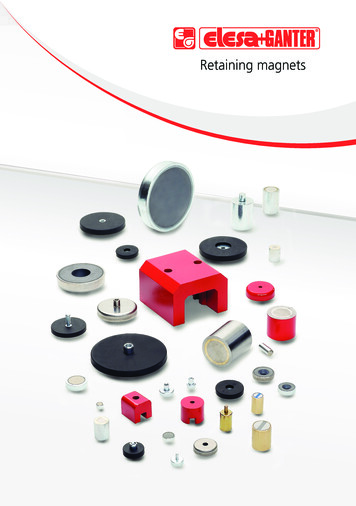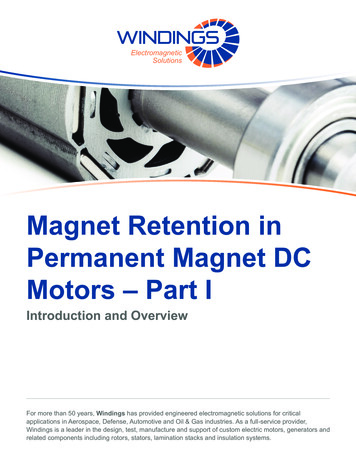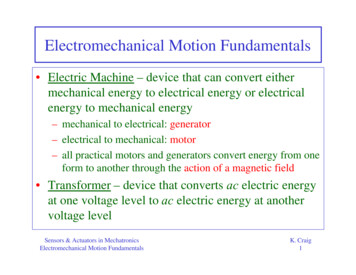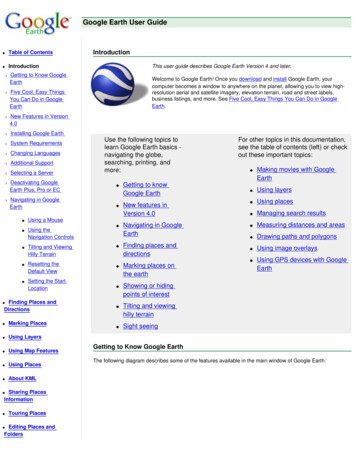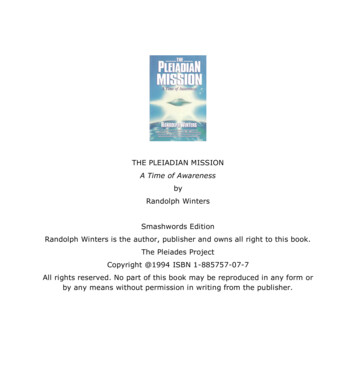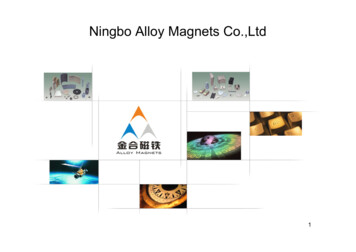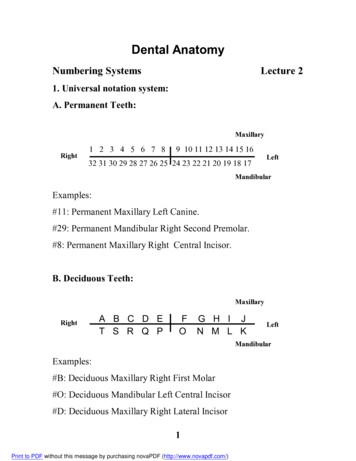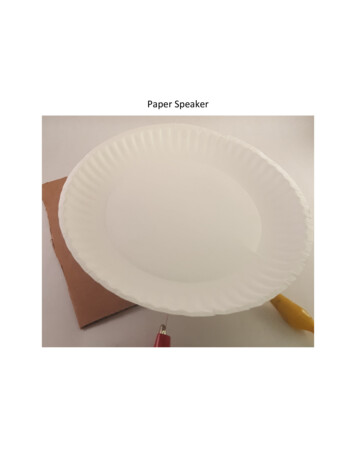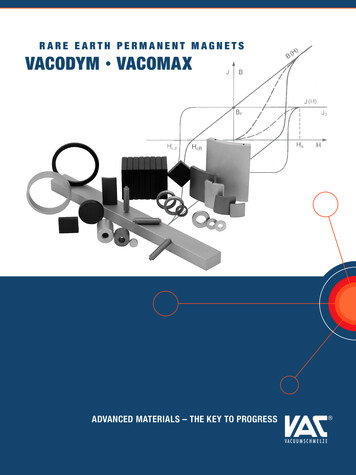
Transcription
RARE EARTH PERMANENT MAGNETSVACOdym VACOmaxAdvanced Materials – The Key to Progress
THE COMPANYVACUUMSCHMELZEVACUUMSCHMELZE GmbH & Co. KG (VAC) is one of the world’s leading producers ofspecial metallic materials with particular physical properties and products producedfrom them. With approximately 4,100 employees worldwide, the company is representedin 50 countries and currently achieves a turnover of approximately EUR 400 million. Theheadquarters and registered office of the company is Hanau, Germany, with additionalproduction plants in Slovakia, Finland, Malaysia and China.
Contents1. Rare earth permanent magnets VACODYM and VACOMAXPage 42. Product rangePage 63. Grain boundary diffusionPage 84. ApplicationsPage 105. Materials and magnetic propertiesPage 146. Limitation of irreversible losses of the magnetic moment (HD5 values)Page 527. Corrosion behaviour, surface protection and coatingsPage 548. Forms of supplyPage 619. Gluing of rare earth magnetsPage 6510. Integrated management systemPage 6611. Safety Guidelines VACODYM and VACOMAX magnetsPage 6812. Appendix – technical basics and termsPage 69VACOdym Vacomax3
1. RARE EARTH PERMANENT MAGNETSVacODYm and VacOmaXTogether with permanent magnets, VAC’s product rangealso includes soft magnetic semi-finished products andparts, inductive components, magnetic shielding and other materials with special physical properties. Apart from rareearth permanent magnets, the range of magnets alsoincludes ductile permanent magnets and magnetically semi-hard materials. The latter are mainly characterized bylow-cost shaping options and adjustable permanent magnetproperties.We have been working on magnetic properties of specialmetallic materials and their applications for more than 70years. In 1973, we started producing rare earth (RE) andcobalt-based permanent magnets using powder metallurgicalprocesses. Under the trade name VACOMAX , this new material group has found widespread applications as a result of optimized production processes and close customerpartnerships.In 1986, we started to produce VACODYM *) magnets on anindustrial scale. These magnets are produced on the basisof neodymium-iron-boron alloys and have the highest energydensities available today. From melting the alloy under vacuumto coating the finished parts, we can carry out all steps in-house and can thus ensure optimised material propertiesover the entire production process. As the European marketleader, we are today one of the world's top-rated producersof rare earth permanent magnets.The magnetic properties of sintered magnets are influencedby the alloy composition and the pressing method. Magnetscan be produced using three different processes. Thesethree processes are reflected in the alloy name with the letters HR, TP or AP. registered trademark of VACUUMSCHMELZE GmbH & Co. KG*) licensor Hitachi Metals Ltd. (Japan)4VACOdym VacomaxHR (High Remanence) refers to isostatically pressed magnets. In die-pressed designs, we differentiate betweenTP (Transverse-Pressed) and AP ( Axial-Pressed). Details onthe available product options are given in Section 8.We continuously pursue intensive development to align ourrange of VACODYM alloys to market demands, for example,for electric drive systems for hybrid or pure electric vehiclesin the field of electric mobility. Both coated, as well asuncoated magnets are used in permanent magnet syn chronous machines, as “embedded“ magnets or surfacemounted magnets. In appropriate applications, the specialorientation profile of our axial-pressed (AP) magnets can enhance performance.In addition to our VACODYM 6XX and 8XX series, which are already well established in the market and can be usedparticularly in motor applications under normal ambient conditions without additional surface coating, we have introduced a number of new alloys to the market with our2XX and 9XX series. VACODYM 238 and 247 do not represent a new performance class, but are dysprosiumfree and thus reduce the dependency on price volatile heavyrare earth metals. The fields of application of this new VACODYM alloy series are particularly synchronous motorswith operating temperatures of up to 130 C, for exampleactuators or power steering motors.For high temperature applications from 160 - 240 C, wehave developed the 9XX series comprising VACODYM 956,965, 974, 983 and 992, which are characterized by increased coercivity when compared to the 8XX series, particularly in case of the high operating temperatures.
For systems with an operating temperature of up to 150 C,we continue to produce magnets of the “7XX series“, whichare characterized by high remanent induction.In the case of temperatures below approximately 140 Kelvin,the maximum energy density is reduced by up to 25 % forconventional VACODYM magnets. Conventional Nd-Fe-B magnets can therefore be normally used to the full extentonly down to 140 Kelvin. For lower temperatures, we have developed two new alloys, VACODYM 131 TP and 131 DTP,which are characterized in that they exhibit the full potentialof Nd-Fe-B magnets even at temperatures far b elow that ofliquid nitrogen (77 Kelvin). Upon request, we would bepleased to send you further information on these newgrades.Cost-effective production units, modern testing techniquesand a quality management system certified according toISO 9001, ISO/TS 16949 and ISO 14001 are as much amatter of course as ongoing further training of our employeesand active environmental protection. With these well-provenprinciples of our business policy, we continue to be your reliable and competent partner.To increase the coercivities, the newly developed grainboundary diffusion procedure can also be used for all VACODYM alloys. More details can be found in Section 3 onpage 8.800(BH)maxFuture possibilitiesof new materials[kJ/m3]700600500(BH)max 485 kJ / m3(Theoretical limits ite0188019001920194019601980200020202040 2060YearFig. 1: Development of energy densities (BH)max of permanent magnets and their potentialVACOdym Vacomax5
2. Product Rangematerial group can be traced to the strongly magnetic matrixphase Nd2Fe14B with very high saturation polarization andhigh magnetic anisotropy. A ductile neodymium-rich b ondingphase at the grain boundaries gives these magnets goodmechanical properties. Fig. 2 gives a comparative overviewof the properties of our VACODYM magnets at 150 C.The product range of our rare earth magnets includes balanced sets of materials with different magnetic p roperties.As a result, it is relatively easy to select a material suitablefor any specific application. VACODYM is the permanentmagnet material offering the highest energy densities currently available. The excellent magnetic properties of this1.18VACODYM956 TP1.16837 TP1.14Remanence Br (T) at 150 C965 TP633 TP1.12854 TP974 TP1.10863 TP655 TP1.08983 TP873 TP1.06669 TP1.04992 TP881 TP890 TP677 TP1.02Fig. 2: Remanence B r and coercivity H cJ oftransverse field pressed VACODYMmagnets at 150 C688 TP1.000.9820040060080010001200 kA/mCoercivity HCJ (kA/m) at 150 CInductionVACOMAX is our permanent magnet material made fromrare earths and cobalt. These magnets have particularly highcoercivities with simultaneous high saturation polarization andexcellent temperature and corrosion stability. In Fig. 3, thetypical demagnetization curves of VACODYM and VACOMAXare compared with the classic permanent magnet materialsAlNiCo and hard ferrite.Fig. 3: T ypical demagnetization curves of VACODYM and VACOMAX in comparison with AlNiCo and ferrite at room temperature.Demagnetization Field H6VACOdym Vacomax
Melting of the alloyunder vacuumCrushingMillingAlignment in magnetic fieldHHIsostaticPPDie pressedPressingPPPHHPTransverse field (TP)THAxial field (AP)Sintering, annealingtMachining, coatingHMagnetizingHFig. 4: ProductionVAC has many years of experience in the production of permanent magnets and the design of magnetic circuits. Aswell as analytical methods, we utilize modern computer programs to analyze and design magnet systems. These include 2D and 3D field calculations using finite elementmethods. Their use decisively shortens the developmenttimes of systems. Therefore besides single magnets, we deliver increasing numbers of complete magnet systems according to customers' specifications.Detailed information on these can be found in our ”MagnetSystems” brochure.The use of soft magnetic materials as flux carrying systemcomponents, e.g. VACOFLUX and VACOFER , enables usto meet customers' specifications. In many cases, properassembly and magnetization of the systems is only possiblewhen the magnets and other system components are assembled directly by the magnet producer.Magnets made of VACODYM and VACOMAX are producedby sintering using powder metallurgical processes. The mainwork steps of the production process are illustrated in Fig. 4. Depending on the size, shape, tolerances, quantity and magnetic requirements, the magnetic parts are either cutfrom i sostatically pressed blocks or are die pressed. During die-pressing, the powder particles can be aligned by strongmagnetic fields parallel (axial field for AP grades) or perpendicular (transverse fields for TP grades) to the direction ofpressing, depending on the geometry of the part. Isostatically or transverse-field pressed parts have approximately5 - 8 % higher remanence values when compared to axialfield pressed magnets.The typical demagnetization curves of our rare earth magnets for various temperatures are available at leadingFEM companies. registered trademark of VACUUMSCHMELZE GmbH & Co. KGVACOdym Vacomax7
3. GRAIN BOUNDARY DIFFUSIONThe coercivity of permanent magnets made of VACODYMcan be increased considerably by using the grain boundarydiffusion process. In this newly introduced production process, sintered permanent magnets are coated with heavyrare earths (HRE) and then undergo a special heat treatment.During the heat treatment, the applied material diffusesalong the grain boundaries into the interior of the magnetand NdFeB grains are formed with HRE-rich shells, which,depending on the thickness of the part, result in an increaseof coercivity ΔHcJ at room temperature by 400 kA/m (5 kOe)up to a maximum of 550 kA/m (7 kOe) (for example illustrated for VACODYM 956 TP in Fig 5). With efficient useof HRE, the reduction of remanence can be limited to lessthan 0.01 T (0.1 kG).8VACOdym VacomaxWhen compared to conventionally produced magnet qualitieswith the same coercivity, additional magnet qualities can beproduced using the diffusion process which have an approx.2 % lower proportion of dysprosium and a 0.04 T (0.4 kG)higher remanence Br.This refining step can, in principle, be applied to all VACODYM sintered magnets that are ground on all sides andis indicated with the letter ”D” in the alloy name (e.g. 956DTP). Starting from the base material and up to a part thickness 5 mm, an increase of HcJ,min by 400 kA/m (5 kOe)can be guaranteed without a considerable reduction of theremanence. However, the characteristic diffusion length ofonly a few millimeters (Fig. 6) results in restrictions if thepart thickness exceeds 5 mm. In such cases, we recommend consulting our team of experts.
DHcJ / kOeDHcJ / kA/mFig. 5: Demagnetization curves of VACODYM 956 TP and VACODYM 956 DTP at 150 CDistance to the magnetic surface / mmFig. 6: C haracteristic dependency of the increase in coercivity ΔH cJ at room temperature with respect to thedistance from the magnetic surface for magnets of different thicknesses d that are coated on both sidesVACOdym Vacomax9
4. APPLICATIONSStationary part of a linear motorMagnets made of VACODYM and VACOMAX have a number of excellentmagnetic properties when compared to conventional magnet materials,such as ALNICO or hard ferrite.THEIR USE RESULTS IN SIGNIFICANT BENEFITS FORTHE USERS: Up to ten times higher energy densities when compared tothose of AlNiCo and ferrite magnets allow for a reductionin the magnet volume (see Fig. 7), as well as miniaturizationof systems and whole assemblies. This can result in savingcost for return paths, coils etc. E xisting magnet systems can be improved in many cases.In general, we recommend redesigning the systems whenusing VACODYM and VACOMAX.MOTORS AND GENERATORSServo drives, DC machines, linear drives and heavy-dutymachines (e.g. engines for rail and ship propulsion, wind turbine and hydroelectric generator systems) predominantlyutilize VACODYM magnets. In addition, our Finnish s ubsidiaryNEOREM Magnets specializes in the production of large-sizemagnets and advanced systems incorporating them (seewww.neorem.fi). VACOMAX magnets continue to be used inthe case of special requirements, particularly high temperatures. Another important area of application is that of smalland fractional HP motors, e.g. dental motors. New design principles are realized and new fields of application are therefore opened.Rotor of a servo motor10VACOdym VacomaxFig. 7: E xample illustrating the volume reduction achieved with VACODYMand VACOMAX: Each magnet is designed to produce a field of100 mT at a distance of 5 mm from the surface of the pole.
AUTOMOTIVE ENGINEERING AND SENSORSSensors to measure varied operating data such as engine,gear and wheel rotary speed (e.g. ABS systems), acceleration(e.g. ESP, airbag) or positions (e.g. throttle valve position, injection systems, camshaft, crankshaft, fuel gauges) areequipped with VACOMAX or VACODYM magnets dependingon the requirements for temperature and corrosion stability.Concentric rotary coupling with VACODYM magnetsVACODYM magnets are also particularly suitable for actuatorsin engine management, auxiliary motors (power steering)and generators.PERMANENT MAGNET BEARINGSDifferent magnetic bearing principles have been developedfor turbo-molecular vacuum pumps, centrifuges and similarapplications. These usually employ axially magnetized ringmagnets. The magnet material is selected according to therespective customer specifications.MRI (MAGNET RESONANCE IMAGING)For imaging systems in medical engineering, permanentmagnet systems with high remanent VACODYM grades areused as well as superconducting and electrically excited systems. The main advantages are the very low energy consumption, savings in weight, a maintenance-free structureand the possibility of building open, patient-friendly systems.MAGNETIC COUPLINGSMagnetic couplings are preferred in automation and chemical processing technology as they ensure permanenthermetic separation of different media. Owing to increasedtemperature requirements, VACOMAX magnets are alsoused for numerous applications. We recommend VACODYMmagnets for lower operating temperatures.Synchronous motors as the main drives in electric and hybrid vehicles are also equipped with VACODYM magnets.Sensor modules with VACOMAX magnets for double clutch gear unit (by courtesy of Volkswagen AG)VACOdym Vacomax11
BEAM GUIDing SYSTEMS,WIGGLERS AND UNDULATORSPermanent magnet beam guides are practically maintenancefree and require no energy supply. Systems with VACODYMor VACOMAX magnets have therefore established themselves in all cases where high field strengths must beachieved within a limited space, e.g. in wigglers, undulators,multipoles and particle detectors. For these applications, accurately matched and compatible magnet sets can bep roduced with narrow tolerances with regard to the m agneticproperties, such as homogeneity and angular position b etweenthe preferred magnetic direction and part geometry. Forlarge-volume parts, economic production processes r esultparticularly from the possibilities of producing large magnetcross- sections with pole surfaces of up to approx. 100 cm2.Undulator structure with VACODYM magnets12VACOdym Vacomax
SWITCHES AND RELAYSFor the widely varying designs of Hall effect switches, polarized relays, revolution counters, etc., magnets or magnetsystems with VACODYM or VACOMAX are used d ependingon the specifications.MEASURING INSTRUMENTSIn this field, the applications range from electronic scales topulse counting meters and mass spectrometers to NMR(Nuclear Magnetic Resonance) measuring systems. Depending on the construction principle selected, systems,armatures or rotors with VACODYM or VACOMAX magnetsare used.Mass spectrometer from INFICON GmbH with a VACOMAX magnet systemVACOdym Vacomax13
5. MATERIALS AND MAGNETIC PROPERTIES5.1 CHARACTERISTIC PROPERTIESTABLE 1: CHARACTERISTIC PROPERTIES OF VACODYM AT ROOM TEMPERATURE (20 oercivityBrtyp.TeslaHR*TP*VACODYM 510 HRVACODYM 633 HRVACODYM 655 HRVACODYM 677 HRVACODYM 722 HRVACODYM 745 HRVACODYM 238 TPVACODYM 247 TPVACODYM 633 TPVACODYM 655 TPVACODYM 669 TPVACODYM 677 TPVACODYM 688 TPVACODYM 745 TPVACODYM 764 TPVACODYM 776 TPVACODYM 837 TPVACODYM 854 TPVACODYM 863 TPVACODYM 872 TPVACODYM 881 TPVACODYM 890 TPVACODYM 956 TPVACODYM 965 TPVACODYM 974 TPVACODYM 983 TPVACODYM 992 .191.351.311.281.251.22* For pressing direction illustrations, see page 16 and 171)14Coding based on IEC 60404-8-1, the magnetic values usually exceed the values of IECVACOdym 2.312.111.8
Temperature coefficientsEnergy density20-100 CHcBmin.2)HcJmin.(BH)maxtyp.(BH)maxmin.TC (Br )typ.TC (HcJ ) TC (Br )typ.typ.kA/m kOe kA/m kOe kJ/m3 MGOe kJ/m3 MGOe%/ C%/ 2.512.111.911.611.3955121275 161670 212230 28875111115 141273 161432 181275 161670 212000 252230 282625 331115 141275 161670 211275 161670 212000 252230 282385 302625 331670 211870 23.52070 262230 282385 423937353431413937353420-150 C%/ CDensityTC (HcJ )typ.typ.%/ tureTmax2)g/cm3 C 0210280230300340370390430320360390410440 The maximum operating temperature is governed by the layout of the system. The approx. values given refer to magnets operating at working points of B/µoH -1(max. energy product). Users are recommended to consult VAC on any application of VACODYM involving temperatures above 150 CVACOdym Vacomax15
TABLE 1: CHARACTERISTIC PROPERTIES OF VACODYM AT ROOM TEMPERATURE (20 oercivityBrtyp.Brmin.TeslaAP**VACODYM 238 APVACODYM 247 APVACODYM 633 APVACODYM 655 APVACODYM 669 APVACODYM 677 APVACODYM 688 APVACODYM 745 APVACODYM 764 APVACODYM 776 APVACODYM 837 APVACODYM 854 APVACODYM 863 APVACODYM 872 APVACODYM 881 APVACODYM 890 APVACODYM 956 APVACODYM 965 APVACODYM 974 APVACODYM 983 APVACODYM 992 01.261.211.171.141.111.291.251.221.191.16Pressing .6Pressing directionTPCoding based on IEC 60404-8-1, the magnetic values usually exceed the values of IECVACOdym 12.512.111.611.211.010.612.311.911.611.411.1
Temperature coefficientsEnergy density20-100 CHcBmin.*HcJmin.(BH)maxtyp.(BH)maxmin.TC (Br )typ.20-150 CTC (HcJ ) TC (Br )typ.typ.DensityTC (HcJ )typ.typ.MaximumoperatingtemperatureTmax2)kA/m kOe kA/m kOe kJ/m3 MGOe kJ/m3 MGOe%/ C%/ C%/ C%/ Cg/cm3 C 0.410.011.811.511.210.910.71353 171512 191355 171670 212000 252230 282625 331115 141355 171670 211355 171670 212000 252230 282385 302625 331670 211870 23.52070 262230 282385 263735333230Pressing directionAP2)T he maximum operating temperature is governed by the layout of the system. The approx. values given refer to magnets operating at working points of B/µoH -1(max. energy product). Users are recommended to consult VAC on any application of VACODYM involving temperatures above 150 C.VACOdym Vacomax17
Table 2: CHARACTERISTIC MAGNETIC PROPERTIES OF VACOMAX AT ROOM TEMPERATURE (20 C)SeepageMaterialCode1)RemanenceBrtyp.TeslaVACOMAX 240 HR200/64VACOMAX 225 HR190/159VACOMAX 225 TP190/159VACOMAX 225 AP170/159VACOMAX 170 HR170/120VACOMAX 145 Coding based on IEC 60404-8-1, the magnetic values usually exceed the IEC valuesTable 3: OTHER CHARACTERISTIC PHYSICAL PROPERTIESOF VACODYM AND VACOMAX AT ROOM TEMPERATURE (20 anceSpecificheatThermalconductivityCoefficient of thermalexpansion20-100 CII c3) CVACODYMVACOMAXSm2Co17VACOMAXSmCo53Ωmm2 /mW/(m K)10-6/KBendingstrength3)kN/mm2N/mm2310-3701.4-1.6 (II c)31.2-1.4 (–I 0-5005-154-1010-16100-13090-180) II c: parallel to the preferred magnetic direction–I c: perpendicular to the preferred magnetic direction18J/(kg K)–I c10-6/KYoung sModulusVACOdym VacomaxThe ranges given in the above table should be regarded as typical rangesand not as tolerance limits.
Temperature coefficientsEnergy density20-100 ngtemperature20-150 CTK (Br )typ.TK (HcJ )typ.TK (Br )typ.TK (HcJ )typ.Tmax2)MGOe%/ C%/ C%/ C%/ Cg/cm3 C 8.425048033Users are recommended to consult VAC on any application of VACOMAX involving temperatures above 200 C.Table 4: I NNER MAGNETIZING FIELD STRENGTH FORVACODYM AND resscrackresistanceK 00-1100500-70040-80MaterialHmag min.kA/mkOeVACODYM250031VACOMAX 225365046VACOMAX 240200025VACOMAX 145/170200025More information on magnetization can be found on page 49.VACOdym Vacomax19
5.2 MATERIAL GRADESVACODYM and VACOMAX are anisotropic materials with a reversible permeability at the working point μrev 1.1. Theexact value depends on the material grade and the magnetgeometry. VACODYM and VACOMAX do not have open porosity, i.e. the pores are not interconnected. Thereforeboth materials can be utilized for vacuum applications. Thefollowing pages illustrate demagnetization curves of differentmaterial grades at various temperatures. Additionally, thetypical irreversible losses are given for different workingpoints depending on the temperature. These charts arebased on HR or TP grades. Axial field pressed magnets haveslightly reduced losses under comparable conditions. Thediagrams of typical irreversible losses take thermalafter-effects into consideration (logically, these are not 20VACOdym Vacomaxi ncluded in the demagnetization curves J(H) and B(H) shown).The resulting time and temperature-dependent opposingfield must be considered in the magnet design, in addition tothe demagnetizing field determined by the respective working point (also see Appendix 12, page 70). It may be assumed for practical purposes that these a dditional opposing fields are in the range of approx. 150 kA/m. Magnet dimensions incorporating considerations of long-term stabilityshould therefore be based on the irreversible losses shownin the following diagrams. The magnetic data and measuredcurves refer to magnets whose minimum dimensions are10 mm perpendicular to the preferred direction and 5 mmparallel to it. In the case of smaller dimensions, there may bedeviations from the curves shown.
5.2.1 SINTERED MAGNETS Based ON NdFeBVacODYm 510Typical demagnetization curves B(H) and J(H)at different temperaturesB/µ0H- ‐1- ‐1.5- ‐2- ‐4VACODYM510HR20 C60 C80 C100 C120 C- ‐0.5kOekA/m1816- ‐140014- ‐120012- ‐100010- ‐80086- ‐6004- ‐40020- - ‐0.2- ‐2- ‐0.4- ‐4- ‐0.6- ‐6- ‐0.8- ‐8J,BHTypical irreversible losses at different workingpoints as a function of temperatureVACOdym Vacomax21
SINTERED MAGNETS Based ON NdFeBVacODYm 633Typical demagnetization curves B(H) and J(H)at different temperaturesB/µ0H- ‐1- ‐1.5- ‐2- ‐4VACODYM633HR20 C- ‐0.5kOe18kA/m60 C16- ‐140014- ‐12001280 C10- ‐1000100 C120 C8- ‐8006- ‐600150 C4- ‐40020- - ‐0.2- ‐2- ‐0.4- ‐4- ‐0.6- ‐6- ‐0.8- ‐8T1.6kG161.4141.2121.0100.880,660.440.220.00- ‐0.2- ‐2- ‐0.4- ‐4- ‐0.6- ‐6- ‐0.8- ‐8J,BHB/µ0H- ‐1- ‐1.5- ‐2- ‐4VACODYM633AP- ‐0.5kOekA/mHTypical irreversible losses at different workingpoints as a function of temperature22VACOdym Vacomax20 C1860 C16- ‐140014- ‐120012- ‐100080 C100 C10- ‐800120 C86- ‐600150 C4- ‐40020- ‐2000J,B
SINTERED MAGNETS Based ON NdFeBVacODYm 655Typical demagnetization curves B(H) and J(H)at different temperaturesB/µ0H- ‐1- ‐1.5- ‐2- ‐4VACODYM655HR20 C- ‐0.560 CkOe18kA/m16- ‐140080 C14- ‐1200100 C12120 C10- ‐1000150 C86- ‐800- ‐600180 C4- ‐40020- - ‐0.2- ‐2- ‐0.4- ‐4- ‐0.6- ‐6- ‐0.8- ‐8T1.6kG161.4141.2121.0100.880.660.440.220.00- ‐0.2- ‐2- ‐0.4- ‐4- ‐0.6- ‐6- ‐0.8- ‐8J,BHB/µ0H- ‐1- ‐1.5- ‐2- ‐4VACODYM655AP20 C- ‐0.5kOekA/m60 C1816- ‐140080 C14- ‐1200100 C12- ‐1000120 C10- ‐800150 C86- ‐600180 C4- ‐40020- ‐2000J,BHTypical irreversible losses at different workingpoints as a function of temperatureVACOdym Vacomax23
SINTERED MAGNETS Based ON NdFeBVacODYm 677Typical demagnetization curves B(H) and J(H)at different temperaturesB/µ0H- ‐1- ‐1.5- ‐2- ‐4VACODYM677HR20 C- ‐0.5100 CkOe18kA/m120 C1614- ‐1400- ‐1200150 C12180 C10- ‐10008210 C6- ‐800- ‐6004- ‐40020- - ‐0.2- ‐2- ‐0.4- ‐4- ‐0.6- ‐6- ‐0.8- ‐8T1.6kG161.4141.2121.0100.880.660.440.220.00- ‐0.2- ‐2- ‐0.4- ‐4- ‐0.6- ‐6- ‐0.8- ‐8J,BHB/µ0H- ‐1- ‐1.5- ‐2- ‐4VACODYM677AP20 C- ‐0.5100 CkOekA/mHTypical irreversible losses at different workingpoints as a function of temperature24VACOdym Vacomax18120 C16- ‐140014- ‐1200150 C12- ‐1000180 C10- ‐8008210 C6- ‐6004- ‐40020- ‐2000J,B
SINTERED MAGNETS Based ON NdFeBVacODYm 722Typical demagnetization curves B(H) and J(H)at different temperaturesB/µ0H- ‐1- ‐1.5- ‐2- ‐4VACODYM722HR20 C60 C80 C100 C120 C- ‐0.5kOekA/m1816- ‐140014- ‐120012- ‐100010- ‐80086- ‐6004- ‐40020- - ‐0.2- ‐2- ‐0.4- ‐4- ‐0.6- ‐6- ‐0.8- ‐8J,
Gluing of rare earth magnets Page 65 10. Integrated management system Page 66 . of neodymium-iron-boron alloys and have the highest energy . magnets can therefore be normally used to the full extent
